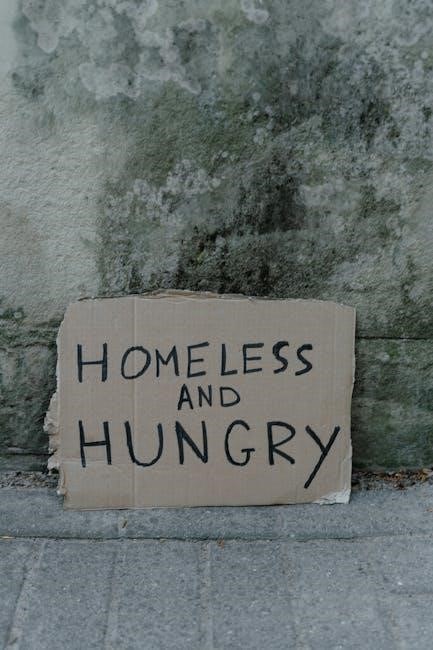Poor Economics by Abhijit Banerjee and Esther Duflo offers a groundbreaking approach to understanding global poverty, challenging traditional views and emphasizing evidence-based solutions to alleviate poverty effectively.
1.1 Overview of the Book
Poor Economics: A Radical Rethinking of the Way to Fight Global Poverty is a seminal work by Abhijit Banerjee and Esther Duflo that delves into the complexities of global poverty. The book challenges conventional approaches to poverty alleviation by presenting evidence-based strategies. It emphasizes understanding the daily lives and decision-making processes of the world’s poorest individuals, highlighting how small, targeted interventions can lead to significant improvements. The authors, both renowned economists, draw on extensive field research to argue for a more nuanced and practical approach to combating poverty.
By focusing on real-world applications and case studies, the book provides actionable insights, making it a crucial resource for policymakers, researchers, and anyone interested in global development. Its innovative perspective has reshaped discussions on poverty reduction worldwide.
1.2 Authors and Their Contributions

Abhijit Banerjee and Esther Duflo, renowned economists and Nobel laureates, co-authored Poor Economics, a groundbreaking work on global poverty. Banerjee’s research focuses on poverty traps, microfinance, and economic development, while Duflo is celebrated for her work on education, health, and gender equality in poverty contexts. Together, they founded the Abdul Latif Jameel Poverty Action Lab (J-PAL), which pioneers randomized controlled trials to test anti-poverty interventions. Their collaborative efforts have significantly influenced policy design, emphasizing evidence-based approaches. The book distills their research into actionable insights, offering a fresh perspective on combating poverty globally.
Key Concepts in “Poor Economics”
The book explores poverty traps, microfinance, and behavioral economics, offering evidence-based policies and insights into the psychology of decision-making among the poor.
2.1 Understanding Poverty Traps
Poverty traps refer to situations where individuals or communities remain stuck in poverty due to structural barriers. Banerjee and Duflo explain that these traps can arise from limited access to resources, high-interest loans, or lack of education. Small challenges, like saving money, can escalate into larger problems, perpetuating poverty. For instance, poor households often struggle to save due to low incomes, making it difficult to invest in better opportunities. The authors emphasize that understanding these traps is crucial for designing effective interventions. They highlight successful strategies, such as microfinance programs, that help break these cycles by providing affordable credit and empowering the poor. Their insights challenge traditional views on poverty alleviation.
2.2 The Role of Microfinance in Poverty Alleviation
Microfinance plays a crucial role in poverty alleviation by providing small loans to individuals lacking access to traditional banking services. In Poor Economics, Banerjee and Duflo highlight how microfinance empowers the poor, enabling them to start or expand businesses. However, they caution that microfinance is not a universal solution. While it can help some escape poverty, it may not address deeper structural issues. The authors emphasize the importance of financial education and complementary strategies to maximize its impact. Their analysis underscores the need for evidence-based approaches to ensure microfinance effectively supports poverty reduction efforts. This balanced perspective helps policymakers design more effective programs.
The Economics of Poverty
Understanding poverty through economic analysis reveals its complexities. Poor Economics examines how poverty is measured, its historical context, and evaluates policy interventions aimed at alleviation, offering insights into why traditional approaches often fail and how evidence-based strategies can better target the root causes of economic disparity. This section provides a foundational understanding of poverty’s economic dimensions and the challenges in addressing it effectively.
3.1 History of Poverty Measurement
The measurement of poverty has evolved significantly over time. Early approaches focused on basic subsistence, while modern methods incorporate multidimensional indicators. Poor Economics highlights how understanding historical shifts in poverty measurement, from income-based metrics to broader assessments of well-being, is crucial for effective policy design. Historical data reveals that poverty lines, such as the $1-a-day benchmark, have been pivotal in shaping global interventions. Banerjee and Duflo emphasize the importance of accurate measurement in identifying the poor and evaluating the impact of anti-poverty programs. This historical perspective underscores the need for adaptive and inclusive metrics to address contemporary poverty challenges effectively.
3.2 Policy Interventions to Address Poverty
Policy interventions to address poverty have evolved, focusing on evidence-based strategies. Poor Economics emphasizes targeted programs like microfinance, education, and healthcare, which address specific barriers faced by the poor. Cash transfer programs, such as conditional cash transfers, have proven effective in improving health and education outcomes. Banerjee and Duflo highlight the importance of integrating services to create a sustainable impact. For instance, providing microloans alongside financial literacy training enhances their effectiveness. The book also advocates for policies that promote economic opportunities, such as vocational training and access to markets; By prioritizing interventions backed by rigorous research, policymakers can design programs that effectively reduce poverty and improve living standards for the poor.

Case Studies and Real-World Applications
Poor Economics showcases real-world applications, such as microfinance success stories, demonstrating how targeted interventions can effectively reduce poverty and improve livelihoods for the world’s poorest populations.
4.1 Microfinance Success Stories

Microfinance has emerged as a powerful tool in poverty alleviation, with success stories highlighted in Poor Economics. Programs like Grameen Bank in Bangladesh demonstrate how small loans can empower the poor, particularly women, to start businesses and improve their livelihoods. These initiatives show that access to credit, even in tiny amounts, can help individuals break the cycle of poverty. Banerjee and Duflo emphasize that microfinance, when implemented correctly, fosters entrepreneurship and financial independence. Such real-world applications underscore the potential of targeted economic interventions to transform lives and communities, offering hope for sustainable poverty reduction.

The Impact of “Poor Economics” on Global Policy
Poor Economics has significantly influenced global policy by advocating for evidence-based approaches to poverty reduction, encouraging policymakers to adopt targeted, data-driven interventions to address economic disparities effectively.
5.1 Evidence-Based Policy Making
Poor Economics has championed evidence-based policy making by emphasizing the importance of rigorous data collection and analysis in designing anti-poverty programs. Banerjee and Duflo argue that traditional approaches often fail due to a lack of understanding of the poor’s decision-making processes. They advocate for randomized controlled trials to test interventions, ensuring policies are grounded in empirical evidence rather than assumptions. This approach has influenced global development organizations to adopt more effective, data-driven strategies. By focusing on measurable outcomes, Poor Economics has reshaped how policymakers address poverty, fostering interventions that are both efficient and impactful.
Reception and Criticism of the Book
Poor Economics received widespread acclaim for its evidence-based approach, winning the 2011 Financial Times Goldman Sachs Business Book of the Year, and influencing global poverty policies significantly.
6.1 Reviews and Awards
Poor Economics garnered significant praise and prestigious awards; It won the 2011 Financial Times Goldman Sachs Business Book of the Year, recognizing its innovative approach to global poverty solutions. The book was also a New York Times bestseller, highlighting its broad impact and reception. Critics lauded Banerjee and Duflo’s rigorous, evidence-based analysis, which provided actionable insights for policymakers and researchers. The awards and accolades underscored the book’s influence in reshaping economic strategies to address poverty effectively. Its success has made it a cornerstone in the field of development economics.

Future Directions in Fighting Global Poverty
Poor Economics emphasizes evidence-based solutions and redirects focus toward sustainable interventions, highlighting the need for innovative financial tools and policy reforms to empower the poorest populations effectively.
7.1 Innovations in Poverty Reduction Strategies
The book highlights the importance of innovative strategies to combat poverty, emphasizing the role of microfinance, digital banking, and targeted social programs. Banerjee and Duflo stress the need for evidence-based interventions, such as conditional cash transfers and agricultural support systems, to address the root causes of poverty. They also advocate for experimentation and adaptability in policy design, ensuring that solutions are tailored to specific contexts. By leveraging technology and data, these innovations aim to create sustainable pathways for the poor to escape poverty traps and achieve long-term economic stability. This approach underscores the potential for transformative change through well-designed and locally relevant initiatives.
Poor Economics offers a transformative perspective on global poverty, emphasizing evidence-based solutions and the need to deeply understand the lives of the poor to create lasting change.
8.1 Summary of Key Takeaways

Poor Economics by Abhijit Banerjee and Esther Duflo provides a comprehensive analysis of global poverty, challenging conventional wisdom. The authors emphasize understanding the daily lives of the poor to design effective solutions. They highlight the importance of evidence-based policies, microfinance, and addressing poverty traps. The book underscores the need for targeted interventions, such as improving access to healthcare and education, to create sustainable change. Banerjee and Duflo’s Nobel Prize-winning insights offer a roadmap for fostering economic growth and reducing inequality. Their work has significantly influenced global poverty alleviation strategies, making Poor Economics a vital resource for policymakers, researchers, and anyone committed to ending poverty.
